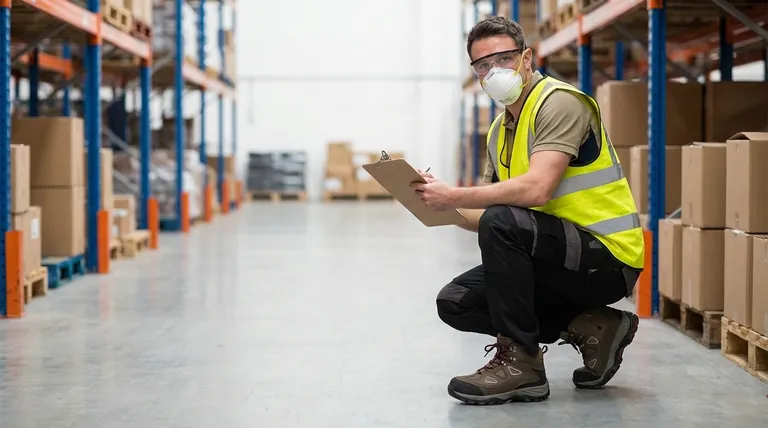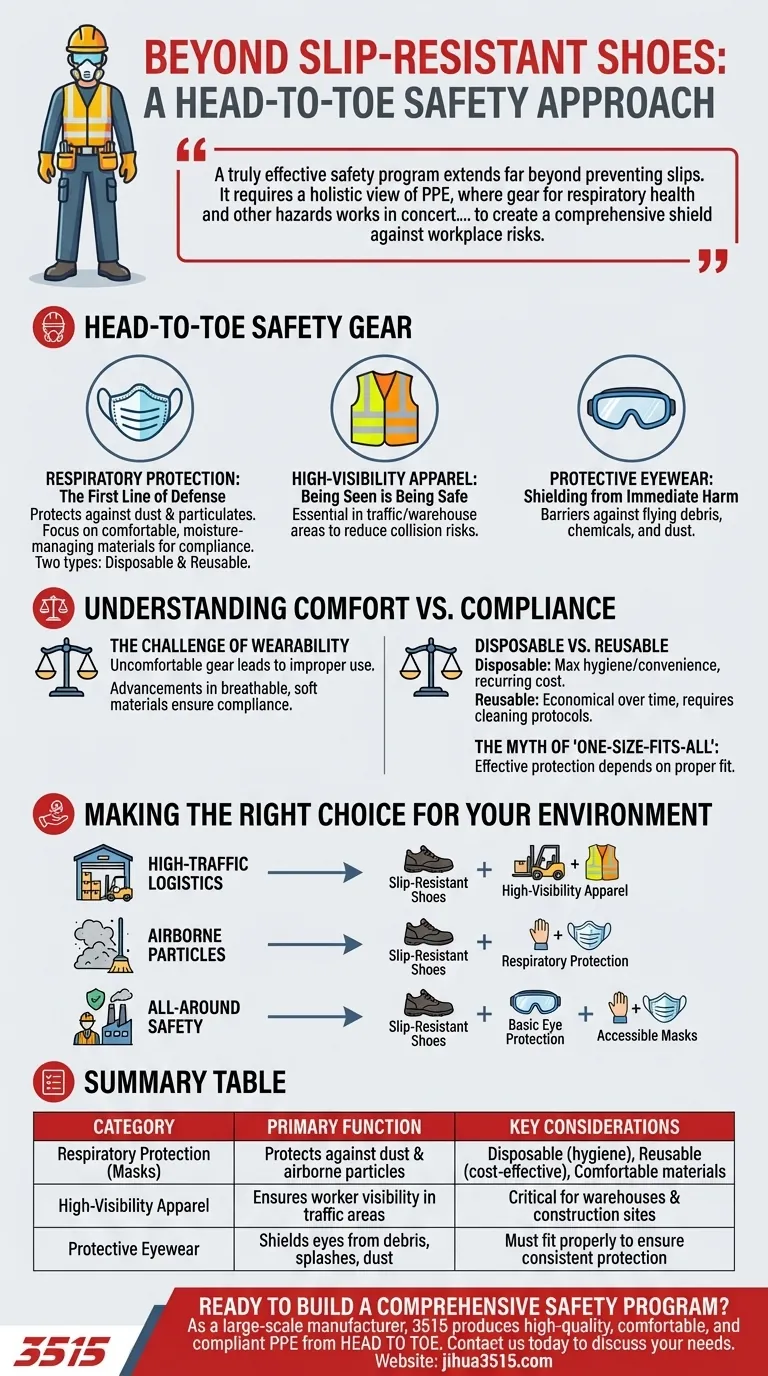Beyond foundational footwear, a key category of safety products available includes respiratory protection like safety masks. These items, offered in both reusable and disposable formats, are specifically engineered with materials that manage moisture and ensure comfort, which is critical for compliance in high-traffic or demanding work environments.
A truly effective safety program extends far beyond preventing slips. It requires a holistic view of personal protective equipment (PPE), where gear for respiratory health and other hazards works in concert with secure footing to create a comprehensive shield against workplace risks.

A Head-to-Toe Approach to Workplace Safety
Thinking about safety systematically—from the head down to the feet—is the most effective way to ensure all potential hazards are addressed. While slip-resistant shoes handle ground-level risks, other equipment protects against entirely different dangers.
Respiratory Protection: The First Line of Defense
The most common addition to a safety uniform after footwear is a safety mask. These are essential in environments with dust, airborne particulates, or close human interaction.
Modern designs focus heavily on user comfort to encourage consistent wear. They often feature soft, moisture-managing materials that prevent discomfort during long shifts.
You will typically find two main types: disposable masks for convenience and hygiene, and reusable masks for long-term cost-effectiveness and reduced waste.
High-Visibility Apparel: Being Seen is Being Safe
In warehouses, construction sites, or any area with vehicle traffic, visibility is paramount. High-visibility vests, shirts, and jackets ensure workers are easily seen by equipment operators, drastically reducing the risk of collision.
Protective Eyewear: Shielding from Immediate Harm
Safety glasses and goggles are non-negotiable in environments with flying debris, chemical splashes, or dust. They provide a critical barrier against projectiles and contaminants that can cause serious or permanent eye damage.
Understanding the Trade-offs: Comfort vs. Compliance
Simply having PPE available is not enough; it must be worn correctly and consistently. This is where the balance of protection, comfort, and practicality becomes critical.
The Challenge of Wearability
If a safety mask is uncomfortable, workers are less likely to wear it properly, compromising its effectiveness. This is why advancements in breathable, soft materials are not just a luxury but a core feature for ensuring compliance.
Disposable vs. Reusable Equipment
Disposable masks offer maximum hygiene and convenience but come with a recurring cost and environmental impact. Reusable masks are more economical over time but require proper cleaning and maintenance protocols to remain effective and sanitary.
The Myth of "One-Size-Fits-All"
Effective protection depends on a proper fit. A mask that gaps at the sides, glasses that slip down the nose, or shoes that are too loose create new safety hazards. Each piece of PPE must be sized correctly for the individual user.
Making the Right Choice for Your Environment
Your specific work environment dictates the necessary combination of safety equipment. Use your primary risks as a guide to building the right protective system.
- If your primary focus is high-traffic logistics or warehousing: Combine slip-resistant shoes with high-visibility apparel to address the dual risks of falls and vehicle collisions.
- If your primary focus is environments with airborne particles (e.g., cleaning, construction): Respiratory protection through properly-fitted safety masks is as critical as your footwear.
- If your primary focus is all-around general safety: A foundational kit should always start with slip-resistant shoes and expand to include basic eye protection and accessible masks for specific tasks.
Building a true culture of safety means equipping yourself and your team with the right protection for every potential hazard, from the ground up.
Summary Table:
| Safety Product Category | Primary Function | Key Considerations |
|---|---|---|
| Respiratory Protection (Masks) | Protects against dust and airborne particles | Disposable for hygiene; reusable for cost-effectiveness; requires comfortable, breathable materials |
| High-Visibility Apparel | Ensures worker visibility in traffic areas | Critical for warehouses and construction sites to prevent collisions |
| Protective Eyewear | Shields eyes from debris, splashes, and dust | Must fit properly to avoid slippage and ensure consistent protection |
Ready to build a comprehensive safety program for your team?
As a large-scale manufacturer, 3515 produces a comprehensive range of personal protective equipment, including industrial footwear, safety masks, and high-visibility apparel for distributors, brand owners, and bulk clients. Our production capabilities ensure high-quality, comfortable, and compliant PPE tailored to your specific work environment.
Contact us today to discuss your safety needs and discover how we can help you protect your workforce from head to toe.
Visual Guide

Related Products
- Safety Footwear Wholesale Manufacturer for Custom OEM/ODM Production
- Premium KPU Injection Athletic Style Safety Shoes
- Wholesale Safety Footwear Manufacturer for Bulk & Custom OEM Orders
- Wholesale Anti-Smash & Puncture-Proof Safety Shoes Custom Manufacturing for Brands
- High Performance Fire-Retardant Waterproof Safety Boots
People Also Ask
- How long can you wear safety boots? The Lifespan is Determined by Wear, Not Time
- What do heavy duty boots do? Protect Your Feet in Demanding Work Environments
- What cultural and environmental considerations are tied to wearing shoes indoors? Balance Hygiene, Tradition, and Foot Health
- How do safety shoes contribute to cost savings for companies? A Strategic Investment in Risk and Cost Management
- Is it normal to wear shoes in the house? A Guide to Hygiene, Comfort & Culture



















